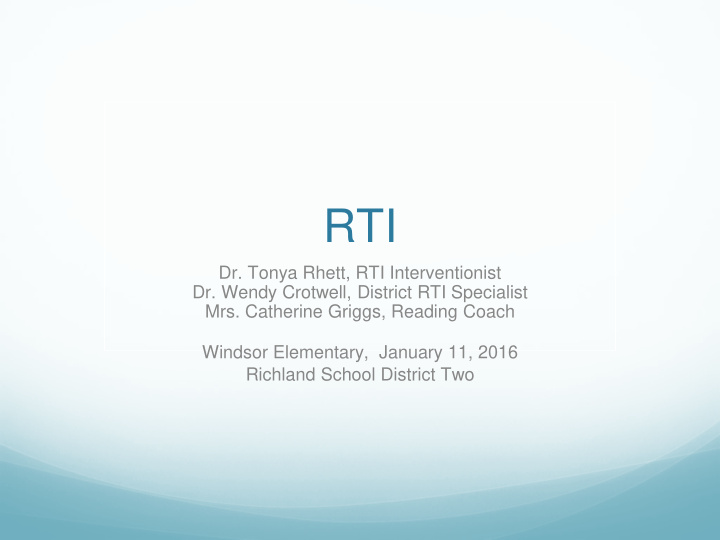



RTI Dr. Tonya Rhett, RTI Interventionist Dr. Wendy Crotwell, District RTI Specialist Mrs. Catherine Griggs, Reading Coach Windsor Elementary, January 11, 2016 Richland School District Two
Catching up Growth ● Why RTI? ● Tony and Maria story from “The Face of a Child” from Annual Growth For All Students: Catch-Up Growth For Those Who Are Behind ● “It is common to find within a kindergarten classroom a five-year range of children’s literacy-related skills…. (some) may have skills characteristic of the typical three-year-old, while others might be functioning on the level of the typical eight-year-old.” -- Dr. Jeni Riley, University of London as quoted in a joint position statement of the National Association for the Education of Young Children and the International Reading Association
The single most cost effective thing is to change this one perception of parents: How would entering kindergarten knowing very few basic skills affect a child’s success in school? 64% of parents believe: “Child will catch up to other children within a year or two”.
Catch-Up Growth When students leave kindergarten three years behind in reading, they must make six years of growth in three years to catch ‐ up by 3rd grade. ● This means they must make one year of annual growth and one year of catch ‐ up growth each year. ● Or, said another way, two years of growth in each 1st, 2nd, and 3rd grades to catch up
MTSS- Multi-Tiered System of Support ● RTI consist of a Multi-tiered system of support beginning with the first tier in the classroom. Once children have been screened at the beginning of the year, we will be able to identify (through multiple pieces of data) at-risk students performing well-below benchmark. ● Assessments for ELA include: DRA, Dibels, next, MAP, ACT Aspire, Treasures benchmarks or District benchmarks ● Assessments for Math include: M-COMP, M-CAP, Envisions benchmarks, MAP, ACT Aspire
Tier I ● Children new to intervention will need to be serviced in Tier I before going to Tier II (Remember: MTSS-Multi-Tiered level of support) ● Children in Tier I, who have been identified at-risk based on current assessment data will need to be provided evidence- based interventions in the classroom for a 6-12 week period. ● Intervention for our at-risk students should occur daily, with progress monitoring occurring 1-2 times a month (Classroom Teachers) ● Helpful resources: www.fcrr.org, www.ebi.missouri.edu/ , www.interventioncentral.org ● Reading Coaches, ELA District Specialist
Tier II ● Children who have been served in intervention the previous year or children who have not made adequate progress in Tier I after 6-12 weeks will be provided Tier II interventions. ● Tier II can be push-in or pull-out but the instruction is more intensive using an evidence-based intervention program. ● No more than 6 children to an interventionist and instruction is daily, approximately for 30 minutes for 6-12 weeks. ● Progress monitoring data is collected more frequently- 2-3 times a month (Intervention Team will collect the data) ● This is in addition to Tier I- The Core (Catching up Growth)
Tier II
Tier III ● Children in Tier II, who have not made adequate progress (based on data collected through progress monitoring and in the classroom) will move into a more intensive tier of support. ● Tier III, if at all possible, should be conducted with a specialized reading teacher for 7-13 weeks. ● Instruction should occur daily with an evidenced-based program (separate from Tier II program) for 35-40 minutes daily. ● Progress monitoring data is collected once a week (Interventionist) ● This is in addition to Tier I-The Core (Catching up Growth)
Tier IV ● Once you have taken a child through all multi-levels of support and progress is still not made (based on progress monitoring data and classroom performance data) the RTI team and classroom teacher(s) can refer student to IAT. ● The decision is made as a team and is in the best interest of the child.
Windsor’s RTI Team MTSS- Interventions Members ● RTI Team: EVERYONE!!! ● Tiers II & III: K-5th (LLI) ● ● Tiers II & III: K-5th (Number IAT Team at Windsor, Tracie Dessausure, IAT chair Worlds) ● Team members: Jennifer Boone, Deta Elkin, Carol Martin, Mandy Rainwater, Stacey Franklin, Jennifer Martin, Beth Elliott, Jamie Whitford, Johnathan Abney, Joy Murray, Danni Priester, Lauren Nelson, Sherrill Creel, Tonya Rhett ● Grade level representatives: K: Carol and Jennifer Martin, First grade: Jamie Whitford; Second grade: Mr Franklin & Mrs. Creel; Third grade: Dr. Rhett; Fourth grade: Tracie Dessausure; Fifth grade: Johnathan Abney
An effective RTI program is built on the approach that when a student struggles, we assume that we are not teaching him or her correctly; as a result, we turn our attention to finding better ways to meet the student’s specific learning needs (Bryson, Maden, Mosty, & Schultz, 2010).
Recommend
More recommend